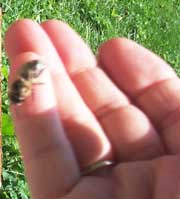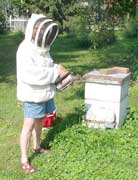|
|
 |
||
|
Volume 13, Issue 31 ~ August 4 - 10, 2005
|
|||

|
 Peering into the Secret Life of Bees Peering into the Secret Life of Beesstory & photos by Vicki Marsh It was no letter Michele Danoff carried out of the Galesville Post Office. Danoff was carrying out a box about 10 inches wide by four inches high with screened sides. Inside huddled 5,000 honeybees, sent by mail to her specification. Danoff used to pick up her bees at the Edgewater Post Office near where she lives. But the new post office didn't like the idea of receiving live bees, so she switched to bee-friendly Galesville, where I was delivering Bay Weekly just as she picked up her bees. This was the closest that I had ever been to a post office delivery of live bees. Danoff sat the bees on her passenger seat and was ready to go. But I wasn't ready to let her go without gaining some information, and peppered her with questions. What are you going to do with these bees? These bees were destined for a friend who lives near Quiet Waters Park in Annapolis, she told me. She was just picking up a delivery for a friend. How'd you get interested in bees? But the day was hot, and the bees were buzzing to be on their way. "You'll have to talk to Rick and Betsy Derrick of Free State Bees," Danoff told me. Listening in on Bees I caught up with the Derricks at the Edgewater Senior Center, where they were giving a talk on honeybees. Maryland is not the ideal place to raise honeybees, began Rick Derrick. "Our season for nectar flow is only about six weeks," he said. But he's got a secret for speeding up the season. "I put sugar water near the hive to fool the bees into thinking that spring is here," he says. "This makes the queen start to produce more worker bees for gathering nectar. The new baby bees will be ready to go once the real spring has arrived." Each beehive, Rick explains, has a significant and amazing social structure. At the top is the queen, of course; nobody is her equal. People are called queen bees when everybody waits on them hand and foot, and the hive is where the saying came from. But no queen is an island unto her own; she needs other bees to survive. Waiting on the queen are both drones (lazy boy bees from unfertilized eggs) and worker bees. A hive or colony won't form without a queen, so Danoff hoped her delivery included that all-important bee. She's larger than any other bee, but the beekeeper puts a white dot on her head to help spot her. The other bees recognize her because she emits a strong odor or perfume. When worker bees are satisfied that everything smells right, they build a hexagonal-celled structure of wax. This wax structure holds honey, the workers' food source, and provides a home for the eggs, which the queen produces with the help of drones. Queens may be pampered, but they're not idle. A queen's task in life is laying eggs, and she takes it seriously, producing up to 1,700 eggs a day throughout a life that may span four years. Some of those eggs will produce more queens to begin another colony or to replace her when she dies. Other eggs are laid to make drones that  mate with the queen. Still other eggs develop into worker bees. mate with the queen. Still other eggs develop into worker bees.To see the hive, I followed the Derricks home to Galesville. Looking in on Bees In the far backyard of the Derricks' big old Victorian home in Galesville, I not only saw a beehive but touched a drone and let him crawl over my hand. It felt like a feather drawn across my skin, it was so soft. I didn't have to worry about getting stung. First, drones lack the stinger with which their sisters, the worker honeybees, are equipped. Second, during the six weeks the workers are gathering nectar, they're too busy making and gathering honey to be bothered by stinging anyone. But if agitated in the fall, when they aren't so busy, a worker may sting. Unlike a wasp or yellowjacket, a honeybee dies once she has stung. So they don't use their stingers unless provoked. Just in case the bees got angry, I was outfitted head to foot in a hat and suit that would make a great Halloween costume. Even my gloves were secured at the wrists with elastic. But I didn't need any of it. Rick Derrick had calmed the bees so we could enter their home. For this job, beekeepers arm themselves with smoke cans that billow smoke to simulate a fire. Bees rush to the nursery to protect the queen and honey at the first indication of fire. But smoke doesn't always mean there's fire. Mostly bees are too busy protecting their home to worry about the beekeeper, so beekeepers seldom have to worry about getting stung. With the bees smoked, Rick removed the top from a hive and slowly withdrew one of the waxed frame structures. There the bees were, lots of them, walking around doing their thing on their honeycomb. I could see the honey inside the many six-sided cells. Once a cell is filled with honey, the workers seal it for storage. Honey cells are small. Bigger cells, Rick explains, are nursery cells where the queen lays her eggs. She walks across the comb, using her antenna to feel out each cell looking for the right size. The 10 percent of eggs destined to become drones are laid in larger cells. A typical Maryland hive raises about 50,000 bees, including about 5,000 drones. What Big Eyes You Have The drones that chew their way out of those cells grow into chubby fat bees with big eyes. The better to see you with, indeed, for those big eyes help them seek out their queen. Born to mate with the queen, they live only about three weeks. "These guys just hang out around the pool hall, drinking beer and smoking cigarettes," Rick says. Outside their pool hall, the hive, the drones hang until a queen flies across their path. They meet, mate in midair, and the job is done. That's his end. His abdomen swells up and he explodes. It's either death by sex or death by starvation for these guys. If a drone survives mating, he will be kicked out of the hive come fall because, after all, he is only a drone; you don't work, you don't eat. Busy As a Bee The saying busy as a bee describes not drones but worker bees, who hatch from smaller cells and make up about 90 percent of each hive. Workers are unfertilized female bees that don't make it to queendom. They're the housewives whose work is never done. The worker bee cleans, she dusts, she takes care of baby eggs, she feeds the queen, she feeds baby bees about 500 times a day, she gets rid of dust bunnies in the wax cells, she stands guard when danger is near and she brings pollen, water and nectar into the hive for food. Whew! And you think you had it tough with just a couple of kids to raise. Workers also act as the hive HVAC, providing heating and air conditioning. In the winter, they keep the hive at a constant 62 degrees by swarming around and over the queen. In January, when the queen starts laying eggs, the workers raise the hive temperature to 94 degrees. Come summer, no matter how hot outside, they keep the inside of the hive at 94. Hives can survive in sunny fields because workers carry water inside and spread it over the cells; cooling begins when the bees start flapping their little wings, circulating the cooler moist air.  Dancing Bees Dancing BeesWorker bees work outside the home as well. Heads down, butts in the air, a little wiggle here gives the direction, and a little wiggle there signals the miles to the nearest source of flowers and pollen. With this directional information, off go the worker bees in search of pollen, water and nectar. When a food source has been found by a scout worker bee, she returns to the hive and dances to announce the find to other workers. Then off they go, crossing highways, surviving storms, animals, humans and insect-eating foes. These ladies travel thousands of miles a season from May through June each year, transporting pollen, water and nectar on their feet and abdomens. Yes, water. Bees need water both to make honey and to air condition the hive. That's how Rick Derrick got in trouble with his neighbors. Neighbors complained that his bees lapped up their bird-bath water and drank all that good sweet hummingbird water. They even drank swimming-pool and hot-tub water. Rick attached quart-sized bottles of water to each of his hives, and now his neighbors are happy. It takes eight pounds of nectar to make one pound of wax, and it takes one pound of wax to hold a pound of honey. A pound of honey takes a million flower trips. Each hive produces over 100 pounds of honey each summer. Sixty to 80 pounds keep the bees alive over a Maryland winter; the rest goes to the beekeeper. Working at that pace, after 40 or 45 days, a honeybee drops dead from exhaustion. Between one thing and another, bees have it tough. In the last decade, America has almost lost its wild bee population due to deadly mites like Varroa — which attaches itself to the back of the bee's head and sucks the life out — and a trackel mite that eats at the bee's trachea. Fewer bees mean less honey. But honeybees are also our prime pollinators; one-third of everything we eat is dependent upon the honeybee for pollination. "How much land do you need to start a bee colony," I asked Rick, thinking I might try my own. He said that he knows of people living in townhouses in Baltimore City who have hives. "You could start one in your own back yard," he said. "but you might want to mention your plan to your neighbors."
|
||
|
|
|||
|
© COPYRIGHT 2004 by New Bay Enterprises, Inc. All rights reserved. |

 About the Author
About the Author